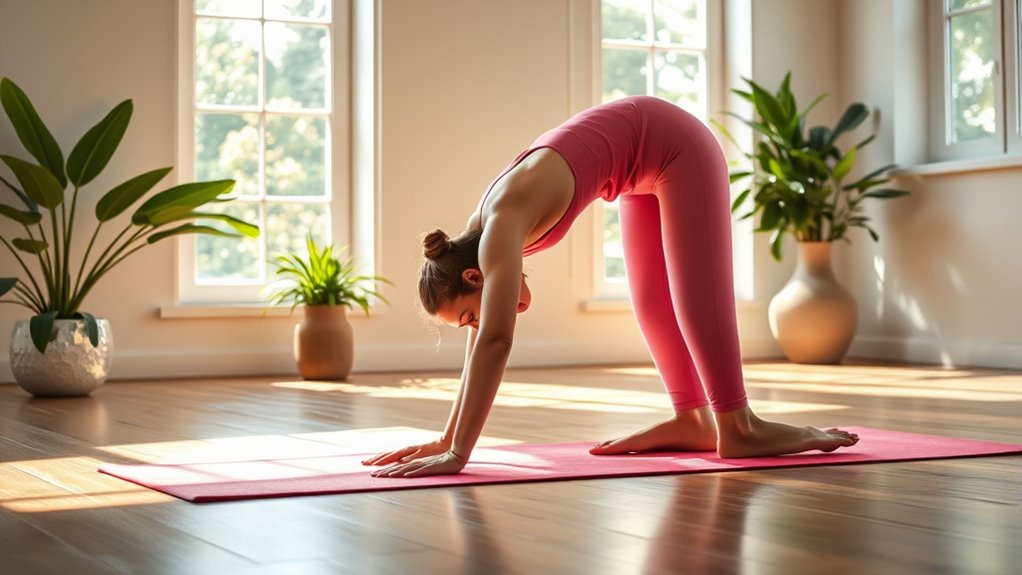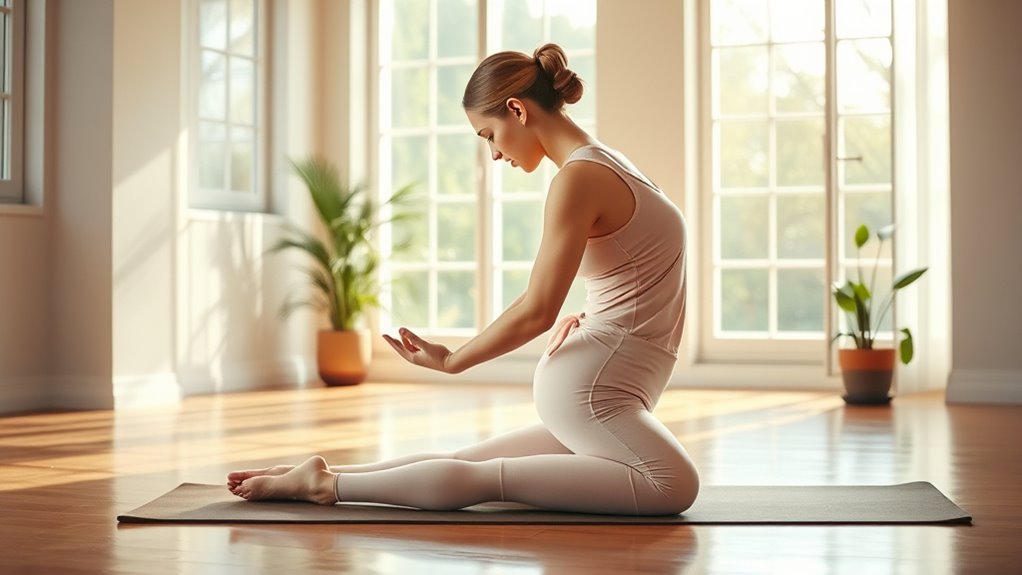To start improving flexibility with yoga, focus on proper breathing techniques like pranayama to stay relaxed and deepen stretches safely. Use props to support challenging poses and maintain proper alignment, which helps prevent injury. Begin with simple poses such as seated forward bends and gentle twists, gradually increasing difficulty as your muscles loosen. Consistency and patience are key, so practice regularly and listen to your body. Keep exploring, and you’ll discover how these practices can transform your flexibility over time.
Key Takeaways
- Start with basic poses like seated forward bends and gentle twists to gradually improve flexibility.
- Use proper breathing techniques (Pranayama) to deepen stretches and promote muscle relaxation.
- Incorporate props such as blocks and straps to support safe, effective stretching and alignment.
- Practice consistently with patience, focusing on controlled movements and mindful breathing for sustained progress.
- Recognize muscle relaxation cues to avoid overstretching and prevent injury during your yoga practice.

If you’re new to yoga and want to improve your flexibility, you’ve come to the right place. Starting your journey with yoga can feel overwhelming, but focusing on proper breathing techniques and using yoga props can make a big difference. Breathing techniques, or pranayama, help you stay relaxed and focused during your practice, which is essential when working on flexibility. Deep, steady breaths increase oxygen flow to your muscles, helping them relax and stretch more effectively. As you breathe in, visualize your muscles opening up; breathe out to release tension. This mindful breathing also keeps you grounded and prevents overstretching, reducing the risk of injury. Understanding the signs of healthy versus overstretched muscles can help you avoid injury and practice safely.
Yoga props are your best friends when you’re just beginning. Blocks, straps, and bolsters provide support, allowing you to access poses that might otherwise be difficult. For example, if you’re trying to deepen a forward fold or hamstring stretch, a yoga block can bring the ground closer to you, making the pose more accessible and comfortable. Using props helps you maintain proper alignment, which is *paramount* for safe stretching and avoiding strain. It also encourages you to hold poses longer, giving your muscles more time to relax and lengthen. Over time, as your flexibility improves, you’ll rely less on props, but in the beginning, they’re invaluable.
Start with simple poses like seated forward bends, gentle twists, and cat-cow stretches. Use your breath to deepen each pose gradually—inhale to lengthen your spine, exhale to fold deeper or twist more profoundly. Incorporate props when needed, and don’t force yourself into uncomfortable positions. Flexibility isn’t built overnight, so patience is key. Consistency matters more than intensity. Aim to practice a few minutes each day, focusing on controlled breathing and gentle stretching. This approach not only enhances flexibility but also builds strength and improves your overall sense of well-being. Recognizing the importance of muscle relaxation can significantly improve your progress and prevent setbacks.
Frequently Asked Questions
How Long Does It Typically Take to See Flexibility Improvements?
You might wonder how long it takes to see flexibility improvements. While it varies, with patience and consistency, most people notice progress within a few weeks. Tracking your progress helps keep you motivated and aware of your gains. Remember, flexibility develops gradually, so don’t rush it. Regular practice, coupled with patience, guarantees steady improvement over time, making your yoga journey more rewarding and sustainable.
Can Yoga Help Prevent Injuries Related to Tight Muscles?
You might wonder if yoga can prevent injuries caused by tight muscles. Research shows that regular muscle stretching during yoga improves flexibility and strengthens muscles, which helps reduce strain and injury risk. When you incorporate yoga into your routine, you actively enhance injury prevention by maintaining healthy, elastic muscles. So, yes—consistent yoga practice can be a valuable tool in keeping your muscles flexible and less prone to injury.
Are There Specific Yoga Poses Best for Increasing Flexibility?
You’re wondering if certain yoga poses are best for increasing flexibility. Some poses, like Downward Dog, Cobra, and Pigeon, target tight areas and enhance flexibility benefits. These poses stretch your muscles, improve range of motion, and gradually loosen tight joints. By regularly practicing these yoga poses, you’ll notice greater flexibility over time, making daily movements easier and reducing injury risk. Consistency is key to revealing your full flexibility potential.
How Often Should Beginners Practice Yoga for Maximum Benefit?
Practicing yoga regularly can transform your flexibility faster than you’d expect, like turning a stone into silk! To see maximum benefits, you should practice consistency—aim for at least 3-4 times a week. Balance your time management, and don’t overdo it; even short daily sessions work wonders. With dedication and regularity, you’ll notice improvements in your flexibility, strength, and overall well-being in just a few weeks.
Do I Need Prior Experience to Start Yoga for Flexibility?
Beginners’ concerns about needing prior experience are common, but you don’t need any to start yoga for flexibility. Yoga is designed to accommodate all levels, so you can begin safely without previous practice. Focus on gentle stretches and listen to your body. With consistent effort, your flexibility will improve over time. Remember, everyone starts somewhere, and prior experience isn’t a requirement to enjoy the benefits of yoga.
Conclusion
Now that you’ve started your yoga journey, imagine the possibilities ahead. With consistent practice, your flexibility will surprise you in ways you never expected. But remember, every pose holds a secret waiting to be unsealed—are you ready to discover what’s next? Keep pushing yourself, stay curious, and the transformation will be worth the effort. The true adventure begins where comfort ends—are you prepared to see how far you can go?









